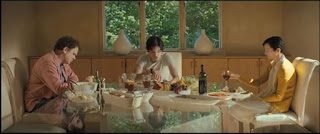Mise-en-Scene in 'We Need To Talk About Kevin'
We Need To Talk About Kevin in relation to Mise-en-Scene
It can be argued that the mise-en-scene in a film can evoke a certain sensory response, depending on how it is presented to us as viewers
In this clip, Eva confronts Kevin after his younger sister Celia was badly injured in his care. Kevin then uses a lychee to taunt his mother regarding the glass eye that Celia will now need to use.
The brightly lit setting with a calm colour palette juxtaposes the anxious conversation taking place. You could imagine this scene talking place in the house in Stoker, yet this setting lures us into a false sense of security. This shows how mise-en-scene can play with our expectations and tone of a scene.
The lighting is key in this close-up - it reflects on the lychee to produce a shiny, mirrored effect, which is successful in Kevin's act of taunting his mother regarding Celia's accident. The lighting also helps us to determine the texture of the fruit itself - we can almost feel its sliminess, and course shell.
'Gombrich’s
definition of texture...the way ‘light behaves when it strikes a particular
surface’, [and] the role light plays in the interrelation between depth and
surface, and how this configures textural qualities’ – Donaldson, Exploring
Space,
p.99
Kevin is positioned in the centre of the frame, and is therefore the centre of our focus. He is also the centre of the film's narrative. Moreover, by the camera positioning in this scene, our attention is drawn towards him, and also the physical space between the family (especially between Eva and Franklin at opposite sides of the table). This shows how the mise-en-scene can reflect themes in the narrative, and encourage us to feel this sense of distance and space.
Costume is also key in this scene. It allows Eva to blend into her background - her yellow cardigan compliments the green trees behind her, yet this peaceful blending of colours and textures is juxtaposed with her own character's rising frustration throughout the scene and her inner anxiety. Again, this shows how mise-en-scene can create a certain appearance of a character which might reject what they are feeling, playing with our expectations as viewers.
‘The
tactile properties of space on film are formed by decisions
made in production design, a creative process which fashions the qualities of
décor, props, materials and objects. The work of the cinematographer and
director shapes the appearance of this material reality via decisions about
lighting and camera placement’ –
Experiencing Space, Lucy Fife Donaldson, p.82
In this quote, I feel that the word 'decisions' is key - every single element of the mise-en-scene are carefully constructed decisions, which are there for a reason, no matter how big, small or irrelevant the object may seem to the viewer.
Moreover, as shown by examples, it's clear how certain aspects of the mise-en-scene can evoke certain sensory responses and create certain expectations which we experience as viewers.





Comments
Post a Comment